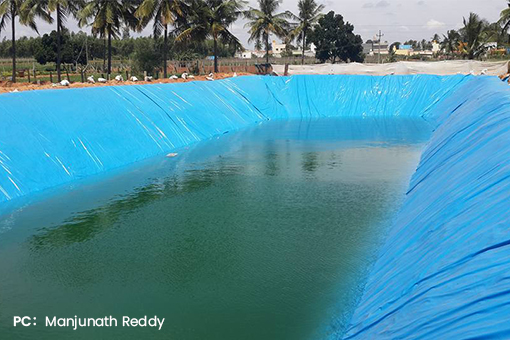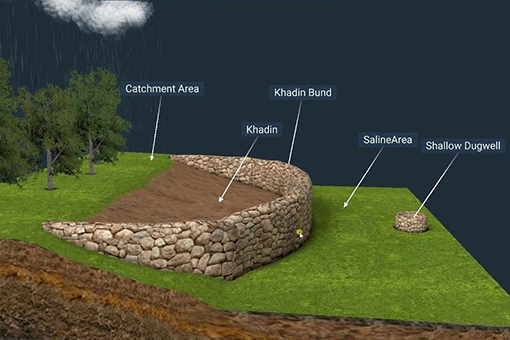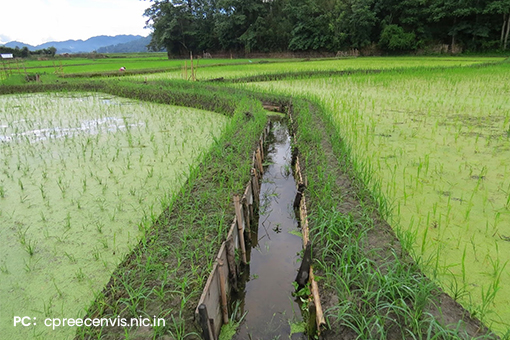Water Conservation : Rainwater Harvesting

As the world faces an increasingly critical need to address climate change, the impact that water conservation has on a sustainable environment is undeniable. Groundwater is the primary source of freshwater that caters to the demand of ever-growing domestic, agrarian and industrial sectors of the country. Over the years, it has been observed that the necessity for the exploitation of groundwater resources for various everyday needs, like toileting, bathing, cleaning, agriculture, drinking water, industrial and ever-changing lifestyles with modernization is leading towards tremendous water wastage.
Though many technological devices are being developed to minimize the water wastage, the impact will be greater if every individual contributes to water conservation by minimizing or optimizing groundwater usage for daily activities. Today, water conservation at individual level has become very critical.
Our water resources are depleting each year. Additionally, we cannot generate artificial water and must depend on water sources available on our planet earth. Due to population boom and excessive need of water to suit our ever-expanding modern lifestyle, water scarcity is felt all over the world. This has given rise to major concerns over water conservation.
In this context, adopting rainwater harvesting and recharging groundwater is one of the simplest and best measures in conserving water globally. This practice can efficiently be implemented in lieu of traditional water supplies that are currently on the verge of tapping out.
RAINWATER HARVESTING
Rainwater harvesting is a simple strategy by which rainfall is gathered and stored for future usage. The process involves collection and storage of rainwater with help of artificially designed systems, that runs off natural or man-made catchment areas e.g. rooftop, compounds, rocky surface, hill slopes or artificially repaired impervious/semi-pervious land surface. The collected rainwater from surfaces on which rain falls may be filtered, stored and utilized in different ways or directly used for recharge purposes. Rainwater Harvesting is unrestricted from any kind of impurity, with relatively less storage cost and no maintenance cost involved except for periodical cleaning.
With depleting groundwater levels and fluctuating climate conditions, this measure can go a long way to help mitigate the adverse effects rising water scarcity. Reserving rainwater can help recharge local aquifers, reduce urban flooding and most notably, ensure water availability in water-scarce zones.

(Source: www.facebook.com/manjunath.reddy )
Advantages of implementing rain-water harvesting:
Reduced Water Bills
Rainwater harvesting systems are cost-effective, provide high-quality water, lessens dependence on wells and are considerably easy to maintain since they are not utilized for drinking, cooking or other sensitive uses. The all-around expenditures used in setting up harvesting methods are much cheaper compared to other purifying or pumping means. The cost of recharge to the subsurface reservoir is also lower than the surface reservoirs.
Ecological benefit
Storing water underground is environment-friendly. The ecological benefits of rainwater harvesting are immense. It minimizes the impacts of flooding by funneling the off water into large tanks for recycling and helps reduce the load placed upon drainage systems. No land is wasted for storage purpose and no population displacement is implicated therefore, groundwater is not directly exposed to evaporation and pollution. Additionally, it helps minimize the possibility of rivers drying up.
Reduces erosion and flooding around buildings
It reduces soil erosion and flood hazards by collecting rainwater and reducing the flow of stormwater to prevent urban flooding. Most buildings that utilize rainwater harvesting systems have a built-in catchment area on top of the roof, which has a capacity of collecting large volumes of water in case of rainstorms.
An adequate means for Irrigation purpose
Harvesting rainwater allows the collection of large amounts of water and mitigates the effects of drought. Most rooftops provide the necessary platform for collecting water. Rainwater is mostly free from harmful chemicals, which makes it suitable for irrigation purposes.
Reduces demand on Ground Water
Another vital benefit is that it increases the productivity of aquifer resulting in the rise of groundwater levels and reduces the need for potable water. It is extremely essential, particularly in areas with low water levels.
There are two major techniques of rainwater harvesting.
1. Surface runoff harvesting
In this method, rainwater flows away as surface runoff and can be stored for future use. Surface water can be stored by diverting the flow of small creeks and streams into reservoirs on the surface or underground. It can provide water for farming, for cattle and also for general domestic use. Surface runoff harvesting is most suitable in urban areas.
Rooftop rainwater/storm runoff can be harvested in urban areas through:
• Recharge Pit
• Recharge Trench
• Tubewell
• Recharge Well
2. Groundwater recharge
Groundwater recharge is a hydrologic process where water moves downward from surface water to groundwater. Recharge is the primary method through which water enters an aquifer. The aquifer also serves as a distribution system. The surplus rainwater can then be used to recharge groundwater aquifer through artificial recharge techniques.
Rainwater in rural areas can be harvested through:
• Gully Plug
• Contour Bund
• Dugwell Recharge
• Percolation Tank
• Check Dam/Cement Plug/Nala Bund
• Recharge Shaft
Although rainwater harvesting measure is deemed to be a desirable concept since the last few years, it is rarely being implemented in rural India. Different regions of the country practiced a variety of rainwater harvesting and artificial recharge methods. Some ancient rainwater harvesting methods followed in India which includes Madakas, Ahar Pynes, Surangas, Taankas, etc.

(Source: www.youtube.com/labinapp )
Examples of Traditional water harvesting system in India
Trans-Himalayan Region
Zing -Tanks for collecting water from melted ice in Ladakh.
Western Himalayas
Kul -Water channels in mountain areas of Jammu, Himachal Pradesh.
Naula -Small ponds in Uttaranchal.
Eastern Himalayas
Northeastern Hill Ranges
Apatani system -Terraced plots connected by inlet and outlet channels in Arunachal Pradesh.
Zabo -Impounding runoff in Nagaland
Bamboo drip irrigation – Water from streams in the hills is brought to the plains via bamboo pipes for drip irrigation in Meghalaya
Brahmaputra Valley
Dongs – Ponds in Assam
Dungs or Jampois – small irrigation channels linking rice fields to streams in the Jalpaiguri district of West Bengal
Indo-Gangetic Plain
Dighis -Small square or circular reservoir fed by canals from rivers in Delhi
Baolis – secular structured stepwells from which everyone could draw water and use for washing and bathing.
Thar Desert
Baoris / Bers -Community wells in Rajasthan
Tankas -Underground tank Bikaner in Rajasthan
Kund – a circular underground well; having a saucer-shaped catchment area that gently slopes towards the center where the well is situated.
Central Highlands
Johads -Earthen check dams in Alwar district, Rajasthan
For further insight on traditional water harvesting system in India please visit http://mahenvis.nic.in/Pdf/Report/report_nrmc_water%20harvesting.pdf
Rainwater Harvesting In Arunachal
Arunachal Pradesh water resources department has executed demonstrative projects on rooftop rainwater harvesting and artificial recharge to groundwater under the cent percent central sector scheme “Groundwater management and regulation” during the 11th Five Year Plan, covering 235 projects in 11 districts. The districts included Tawang, West and East Kameng, Papum Pare, Kurung Kumey, Lower and Upper Subansiri, East and West Siang, Lower Dibang Valley, Anjaw, Miao (Changlang), Tirap and Longding. Out of the above, 100 projects were implemented in government schools, hospitals, primary health centers, office buildings, Circuit houses, and inspection bungalows. These projects were successfully executed and handed over to the user agencies for operation, maintenance and its utilization for various water needs. The first successful projects carried out by the Arunachal Pradesh water resources department was in Ruksin in East Siang district during 2002-03.

(Source: www.cpreecenvis.nic.in )
The Apatani’s System – a wet rice cultivation cum fish farming system practiced in elevated regions of about 1600 m and gently sloping valleys. This system harvests both ground and surface water for irrigation. It is practiced by Apatani tribes of Ziro in the Lower Subansiri district of Arunachal Pradesh.
In the Apatani’s system, valleys are terraced into plots divided by 0.6 meters high earthen dams which are then supported by bamboo frames. All plots have an inlet and outlet on opposite sides. The inlet of low lying plot functions as an outlet of the high lying plot. Deeper channels connect the inlet point to the outlet point. The terraced plot can be flooded or drained off with water by opening and blocking the inlets and outlets as and when required. The stream water is tapped by constructing a wall of 2-4 m high and 1 m thick near forested hill slopes. This is conveyed to agricultural fields through a channel network.
Conclusion
Harvesting and collection of rainwater is an adequate strategy that can be used to address the problem of water crisis globally. The use of a rainwater harvesting system provides excellent merits for every community. This simple water conservation method can be a boost to an incredible solution in areas where there is enough rainfall but not enough supply of groundwater. It will not only provide the most sustainable and efficient means of water management but also unlock the vista of several other economic activities leading to the Empowerment of people at the grass-root level.
For this, the Government should come out with an appropriate incentive structure and logistic assistance to make it a real success. Rainwater harvesting is something that thousands of families across the world should participate in rather than pinning hopes on the administration to fight water crisis. This water conservation method is a simple and effective process with numerous benefits that can be easily practiced in individual homes, apartments, parks and across the world. As we all know that charity begins at home, likewise, a contribution to society’s welfare has to be initiated from one’s home.



Total Comments - 0